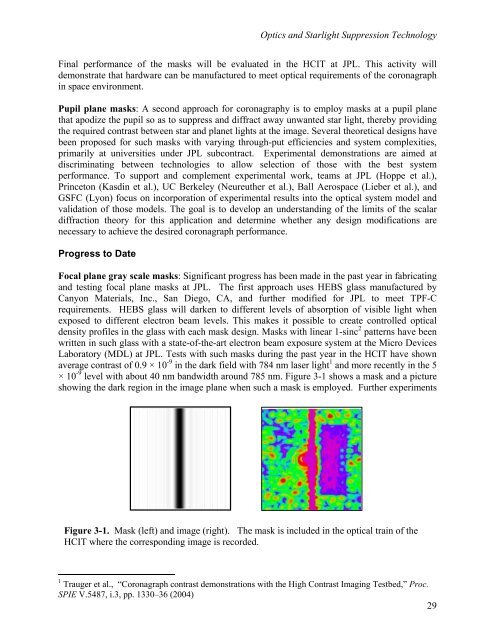TPF-C Technology Plan - Exoplanet Exploration Program - NASA
TPF-C Technology Plan - Exoplanet Exploration Program - NASA
TPF-C Technology Plan - Exoplanet Exploration Program - NASA
Create successful ePaper yourself
Turn your PDF publications into a flip-book with our unique Google optimized e-Paper software.
Optics and Starlight Suppression <strong>Technology</strong><br />
Final performance of the masks will be evaluated in the HCIT at JPL. This activity will<br />
demonstrate that hardware can be manufactured to meet optical requirements of the coronagraph<br />
in space environment.<br />
Pupil plane masks: A second approach for coronagraphy is to employ masks at a pupil plane<br />
that apodize the pupil so as to suppress and diffract away unwanted star light, thereby providing<br />
the required contrast between star and planet lights at the image. Several theoretical designs have<br />
been proposed for such masks with varying through-put efficiencies and system complexities,<br />
primarily at universities under JPL subcontract. Experimental demonstrations are aimed at<br />
discriminating between technologies to allow selection of those with the best system<br />
performance. To support and complement experimental work, teams at JPL (Hoppe et al.),<br />
Princeton (Kasdin et al.), UC Berkeley (Neureuther et al.), Ball Aerospace (Lieber et al.), and<br />
GSFC (Lyon) focus on incorporation of experimental results into the optical system model and<br />
validation of those models. The goal is to develop an understanding of the limits of the scalar<br />
diffraction theory for this application and determine whether any design modifications are<br />
necessary to achieve the desired coronagraph performance.<br />
Progress to Date<br />
Focal plane gray scale masks: Significant progress has been made in the past year in fabricating<br />
and testing focal plane masks at JPL. The first approach uses HEBS glass manufactured by<br />
Canyon Materials, Inc., San Diego, CA, and further modified for JPL to meet <strong>TPF</strong>-C<br />
requirements. HEBS glass will darken to different levels of absorption of visible light when<br />
exposed to different electron beam levels. This makes it possible to create controlled optical<br />
density profiles in the glass with each mask design. Masks with linear 1-sinc 2 patterns have been<br />
written in such glass with a state-of-the-art electron beam exposure system at the Micro Devices<br />
Laboratory (MDL) at JPL. Tests with such masks during the past year in the HCIT have shown<br />
average contrast of 0.9 × 10 -9 in the dark field with 784 nm laser light 1 and more recently in the 5<br />
× 10 -9 level with about 40 nm bandwidth around 785 nm. Figure 3-1 shows a mask and a picture<br />
showing the dark region in the image plane when such a mask is employed. Further experiments<br />
Figure 3-1. Mask (left) and image (right). The mask is included in the optical train of the<br />
HCIT where the corresponding image is recorded.<br />
1 Trauger et al., “Coronagraph contrast demonstrations with the High Contrast Imaging Testbed,” Proc.<br />
SPIE V.5487, i.3, pp. 1330–36 (2004)<br />
29
















